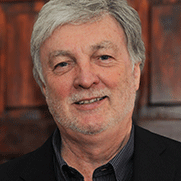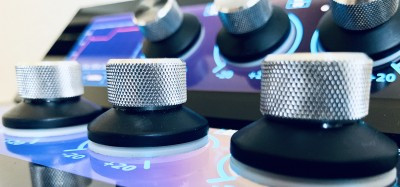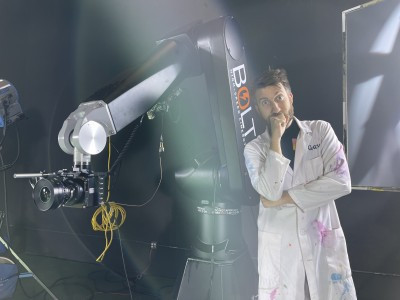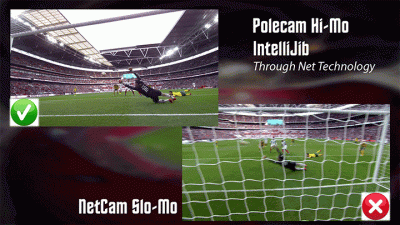by Mel Noonan Issue 98 - February 2015
Super slow motion, or super motion, has been around for years and is mostly 3x recording speed. If you record say 3 seconds of action and play it back at normal European production frame rate you\'ll have 9 seconds of slow motion replay. These cameras must integrate with the live production workflow in use. SSM HD cameras are still very much in use today for fast sports like soccer.
The newer ultra motion, or hi-mo camera systems offers much higher speeds and slower replays and are now available to fit into the production workflow. You will find them being used alongside SSM systems for HD broadcasts, and manufacturers are already presenting 4k ultra motion systems too.
LMC, a high speed camera manufacturer in Germany has partnered with Polecam Systems in the UK to develop a new ultra motion minicam, the Antelope PICO, which operates at up to 350 fps in HD. LMC Technical Director Christian Schreiber: "We have a range of high speed cameras under the Antelope name, but recently, besides getting higher and higher frame rates our goal has been to reduce the size of the camera to a minimum."
"With the Antelope PICO you gain many more possibilities to put the camera into environments where you can shoot high speed footage which has not been seen before. We collaborated with Polecam Systems to fit the PICO into a modified Polecam FishFace underwater housing and shoot high speed not only underwater, but on a Polecam so with a moving POV capability over and under water - a milestone in high speed, never seen before on live broadcast. Also we integrated a deflicker option to shoot high speed under artificial light. We can provide a zoom, focus and iris remote too, for C mount las well as B4 mount lenses.\"
Polecam\'s designer Steffan Hewitt: "I\'ve just returned from covering the 25 metre World Swimming Championships in Doha, Qatar. I started with a Toshiba HD camera on the rig but once FINA saw the footage from the PICO tests we did
(www.polecam.com/latest-news/679-fishface-pico-slow-motion-swimming ) they asked us to see what we could do in the time left. The last 2 days saw the PICO in action generating some fantastic footage.\"
Steffan explains here what\'s involved in operating the PICO in the underwater housing on Polecam. Of course the PICO will operate anywhere as a standalone minicam and the Polecam will take many other cameras.
"Polecam is a crane and it\'s a balanced system. Once you\'ve determined what length you want to use, (i.e. the number of carbon fibre poles), you put the remote pan & tilt head and the camera at the top of the boom, and that length and weight determines the weight that goes on the back - it becomes a balanced system. Because Polecam is so lightweight and balanced it actually becomes more like a Steadicam than like say, a Jimmy Jib.
"A normal Jimmy Jib would be driven from the back, and the area you need to work in, because you\'ve got to be able to walk around the base, is very large. A Polecam is driven standing alongside and is much more of a balanced system. Really you\'re just using your fingers to move the boom.
"If you are right handed, with your right hand you have the joystick giving you camera pan and tilt, and with your left hand you\'ve got in effect, pan and tilt of the boom, and it\'s very much a dance between the two, because sometimes you can be locked on to a subject but be panning, tilting and booming at the same time while keeping the subject in the centre of the frame. What that does, is to allow the background to change - to bring things into the foreground and take them away, making the shot much more interesting.
"By adding the PICO, from a cameraman\'s point of view, there\'s very little change with regards to physical equipment. You have the camera and CCU; but what is very different is the operating style. With an ordinary camera you are into smooth, slow booming shots, and smooth, slow pan and tilt because you don\'t want it fast and jerky. But with ultra motion, once you slow these shots down, maybe a tenth of normal speed, a nice, smooth panning and booming shot will actually look almost static, and therefore to keep movement in the shot, you have to move very fast.
"If I\'m shooting swimming, I move in and out of the water very quickly, otherwise it would just take too long on replay. If I\'m shooting handball, booming across the floor of the court, I\'ll move very quickly. When it\'s slowed down it keeps the movement in there and looks great.
So how does PICO work in practice?
"There are two remote units, an RCP and an OCP. One controls the camera iris, colour balance and setup parameters, and the other is very similar to an EVS unit, designed specifically for logging, banking and replaying the shots which we often replay directly into an EVS server. So there are two people required; the Polecam operator, and the slo mo operator who manages the ultra motion workflow, and may also manage the camera adjustments, or that may be done by an engineer in the truck.
"Within the camera CCU at the back of the Polecam is 8GB of RAM that is constantly loop recording. With the PICO you don\'t start recording , you only stop recording; if you try and start recording, by the time you hit start and it\'s recording, the event\'s probably gone or half gone. Consider a whale surfacing. By the time you see the whale coming out of the water and hit record, it\'s too late - you\'ve missed it.
"So for example, at 1080i, 50 Hz, running at 350 fps, with 8GB of RAM, this gives me approximately 12 seconds in the past. At any point you can stop recording and wind backwards 12 seconds, and whatever\'s been happening, you will catch it. That 12 seconds, to replay at normal speed, takes about 2 minutes. With the whale surfacing, by the time it has jumped into the air and splashed down again, bang, the PICO operator triggers it and then has the ability to replay that shot instantly.
"So if the operator\'s triggered an event and it\'s playing out, what happens if something else occurs while that\'s playing out? You can break up this 12 second 8 Gigabytes of RAM in up to four different banks. So you could have say, four 3 second banks, each 3 seconds equating to about thirty seconds of replay time, which is a lot. The beauty of it is not only can you be replaying that clip out, but if something else happens, you can trigger a second event - and once event one\'s played out you can then play out event two, and cancel event one.
"Importantly PICO has two outputs - a permanent live feed that can be cut with the other cameras at any time, but also the ultra motion replay channel; and they are independent, so you can use the PICO as a permanently live camera and also for ultra motion replays. If you wanted to record you could have two recorders - one for the normal output, and one for the ultra motion replays for later editing."
www.polecam.com






























